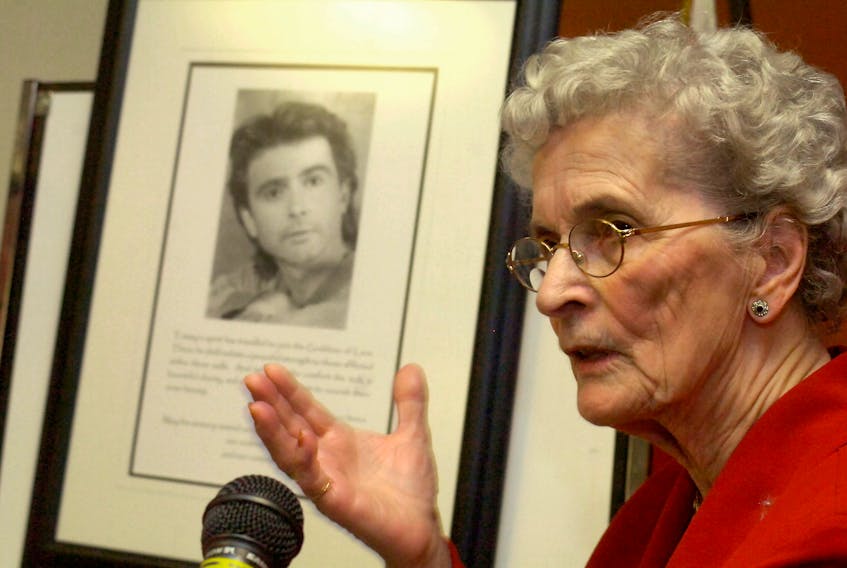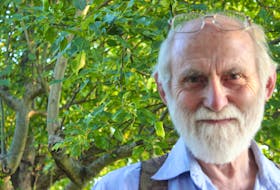When Tommy Sexton broke down and told his mother he had AIDS, Sara Sexton couldn’t wipe one thought out of her head.
“All I could think of was he’s going to die,” she recalled in 2006. “I couldn’t get past that.”
But she told her son not to worry, and supported him to the very end.
Sara Sexton’s death in February of this year marked the passing of a painful legacy in Newfoundland and Labrador, one it shared with the rest of the world.
Well into her 90s, Sara kept a candle burning for those struggling with the disease that took her son — a well-loved actor and member of the comedy troupe Codco — from the world in 1993.
Within a year of Tommy’s death, she had envisioned a local facility for people with AIDS. That vision came to fruition in 2006 when the Tommy Sexton Centre was opened in St. John’s. Backed by government funding, donations and annual fundraisers, the centre offers temporary shelter, counselling, referral services and a needle exchange.
When Tommy died at the age of 36, AIDS was not only looked at as a death sentence, but also carried the stigma of being a gay person’s disease.
The most tragic part is that if Tommy had contracted HIV (the virus that causes AIDS) only a few years later, his chances of survival would have been significantly higher.

Changing times
Gerard Yetman has seen the changing landscape of AIDS since the beginning.
Executive director of the AIDS Committee of Newfoundland and Labrador, he remembers when life-saving medications first came on the scene.
“In the 1990s, most of our cases were young gay men returning home from Toronto and Vancouver to die at home,” he told The Telegram
“Over the last 30 years, we’ve seen quite a lot of changes, particularly since about 1994-95. That’s when the treatments improved a lot, and mainly because they started the HAART therapy.”
HAART (Highly active antiretroviral therapy) means people living with HIV/AIDS today often only have to take one pill rather than the 15 or more that were prescribed 25 years ago.
Yetman says that in the past five years, treatments for AIDS have become so effective that about 98 per cent of those affected die of other age-related conditions rather than complications from the infection.
While there is a preventive daily drug high-risk people can take to decrease the chance of infection — called PrEP, or pre-exposure prophylaxis — a vaccine for AIDS has so far been elusive.
“At this point in time, there doesn’t seem to be a lot of hope in the area of a vaccine for HIV,” Yetman said.
Canadian researchers worked on it for eight years before funding dried up, but other labs around the globe are still trying.

Hard target
One of those is a team at Brigham and Women’s Hospital in Boston, one of a number of U.S.-based labs that paused its pursuit of an AIDS vaccine to work on one for COVID-19. They are now in the final Phase 3 trials under the banner of Moderna Inc.
“We’ve had a lot of incremental improvements over the past several decades on what an HIV vaccine might have to do in order to protect people, but it’s been very slow and very incremental,” Stephen Walsh told The Telegram in August.
Walsh, a native of Mount Pearl, says the virus is hard to nail down.
“HIV is a particularly tough target,” he said. “We don’t like to ascribe intelligence to viruses, but it helps with the language. The virus has a lot of strategies for invading the immune system, and that’s really impeded vaccine development.”
Chief among those strategies is that there are a lot of different HIV strains around the world. That raises the question of whether researchers should try to come up with a regional vaccine — which will only work in one part of the world — or work on one that might work everywhere.
“There have been estimates that the viral diversity of HIV just within Boston is higher than the influenza virus diversity worldwide,” he said.
Nonetheless, the Brigham and Women’s Hospital team was about to launch rare Phase 3 trials on a universal vaccine this spring until COVID-19 intervened.
Stigma persists
Despite a noticeable rise in Canadian AIDS numbers in recent years — from 1,963 in 2015 to 2,561 in 2018, the last year statistics are available — Yetman says the Newfoundland numbers have lingered below 15 annually. That may be partly due to stagnant testing numbers, something the committee tries to combat in its awareness campaigns.
“One of the things that we’re discovering through our education initiative is, particularly a lot of young people think that it’s already cured because we’re not seeing the death rate that we saw, so it’s not in the media,” he said.
And he criticized the fact Canada still prosecutes people who have sex without informing their partner in some cases.
“Criminalization of HIV is a bad public health measure. What ends up happening is that a lot of people don’t even want to know their status because then there’s a chance that they could end up in jail.”
Twitter: @pjackson_nl









